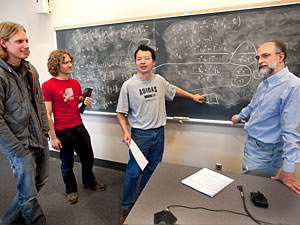Math whizzes from the U help businesses with real-world problems

They do the math
If you tried to name Minnesota companies that have tapped the skills of young mathematicians at the University of Minnesota, you would almost certainly guess a few of them.
That's because numerous hi-tech firms around the state are contributing partners of the U's Institute for Mathematics and Its Applications (IMA).
Through its "Industrial Postdocs" program, the IMA pairs newly minted math Ph.D.s—postdoctoral fellows, or postdocs—with companies that can use their expertise to improve their product lines—or their bottom lines.
"The great thing about it is, companies get to have a fresh Ph.D. in math look at their [important] problems and help them see through the difficulties," says IMA Director Fadil Santosa. "Sometimes, this leads to a new or improved product."
Also, postdocs who weren't thinking about careers in industry may change course when they see the impact of their research. For example, Laura Lurati (postdoc 2006-08) did a project with Boeing in Seattle and is now a key scientist there.
The IMA usually has two or three postdocs in training every year, says Santosa. Since the Industrial Postdoc program began around 1988, about 60 mathematicians have benefited from it.
But it isn't just postdocs who help companies. It's also University faculty, including Santosa himself. And companies sometimes hire graduate students to work over the summer.
"We have a reputation around the United States as the place to go with challenging industrial problems," Santosa says.
Here are some examples of how the people of IMA have helped companies.
Honeywell
Working at Honeywell in the 1990s, IMA postdocs David Dobson and Gang Bao wrote computer codes to design a general class of diffractive optics. These novel optical elements were made on flat glass and enabled more compact sensors to detect dangerous gases like nerve agents or carbon monoxide in infrared light.
But Dobson's and Bao's computer work went much further.
"That software is part of our toolbox that we use routinely in all kinds of applications," says Allen Cox, a senior research fellow at Honeywell. "For example, we have a terahertz [frequency] camera in development that can see through clothing and is intended to detect concealed weapons."
Later, work by postdocs Nathan Kutz and Lei Wang helped Honeywell design laser and optical fiber communications. Their work helped the company acquire several patents and develop product designs that enhanced the value of a laser-based business Honeywell sold in 2004 for $75 million, says Cox, who worked with all four postdocs.
3M
At 3M, IMA postdoc Douglas Huntley worked on a system for monitoring red blood cells during surgeries where a patient is on a heart-lung machine. In procedures like coronary artery bypass, surgeons frequently stop the heart and circulate the blood and replenish its oxygen with a machine. The monitors determine the number of red blood cells and how well they are oxygenated from how much light is reflected from the blood.
"Doug's work provided a fundamental, quantitative understanding of how the monitors worked, which complemented the extensive experimental verification of the product's performance," says 3M manager David Misemer, who supervised Huntley's work. "It gave us an extraordinarily complete picture of the performance of the device so we could send it to market with even greater confidence.
"The industrial post doc appointment was a great opportunity for Doug to explore the R&D experience in industry while remaining connected to academia, letting him make much more informed decisions about a career path. And it was great for 3M because we had a talented mathematician who had the time to explore an issue in great depth."
Medtronic
Sometimes, surgeons want to destroy, or "ablate," cardiac tissue. In some operations, they use Medtronic's surgical ablation devices to heat—via an electrode that delivers radio-frequency energy—and kill aberrant cells through the full thickness of the heart wall. The tip of the electrode also exudes saline to cool nontargeted heart cells and more effectively couple the electrode to the tissue.
At Medtronic, IMA postdoc Jay Gopalakrishnan developed a mathematical model of the temperatures achieved during the use of the device.
"We're working on optimizing the device under different conditions and using Jay's input in new device designs," says David Francischelli, director of research and development at Medtronic.
"His work led to a deeper understanding of the biophysics of tissue response and allowed us to provide better guidance to our customers who are using the devices—that is, surgeons. Ultimately, this product line has treated upwards of 150,000 patients."
